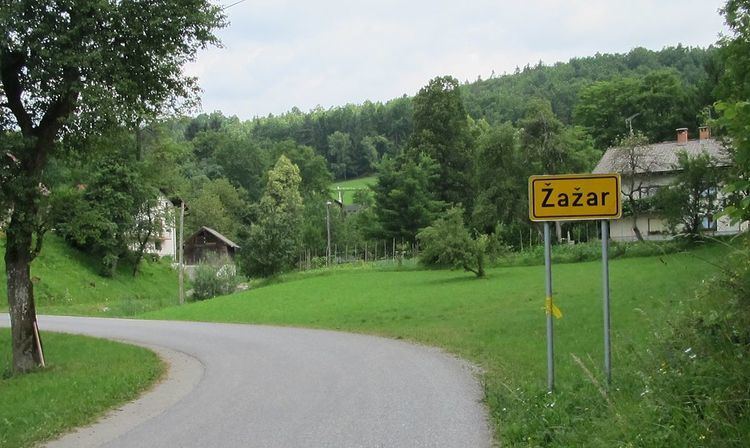Area 4.9 km² Population 169 (2002) | Elevation 445 m Local time Monday 3:56 AM | |
 | ||
Weather 6°C, Wind S at 2 km/h, 88% Humidity | ||
Žažar ([ˈʒaːʒaɾ]; German: Saschar or Schaschar) is a village in the hills southwest of Horjul in the Inner Carniola region of Slovenia. It includes the hamlet of Razpotje. Southwest of the settlement core is the Jevše Valley with a watering hole for livestock. The Trešnica Gorge and Gošava Spring lie northeast of the settlement core. The territory of the settlement includes the following hills: Koprivnik Hill (551 m), Babca Peak (Slovene: Babčin vrh, 503 m), Gradišče Hill (547 m), and Žažar Hill (447 m). There is an opening into 130-meter-long Pajsar Cave (Pajsarjeva jama) in the southern part of the settlement.
Contents
- Map of 1354 C5BDaC5BEar Slovenia
- Name
- History
- Second World War
- Mass graves
- Church
- Cultural heritage
- References
Map of 1354 %C5%BDa%C5%BEar, Slovenia
Name
Žažar is also known locally as Žajžar. The priest and historian Peter Hicinger explained the name as meaning žarišče 'focal point of a fire', from the verb žariti 'to heat (red hot)'. In the past it was known as Saschar or Schaschar in German.
History
There is a walled prehistoric burial ground on Gradišče Hill. A school was established in Žažar in 1913. A school building was built in 1927.
Second World War
The village was partially burned by Italian troops on 9 June 1942. At the end of January 1943 the Partisans attacked an Italian stronghold at the elementary school in Žažar.
Mass graves
On 2 August 1942, nine civilians from Šentjošt nad Horjulom and other nearby villages were taken to the forest west of Žažar by the Partisans and murdered. Their bodies were thrown into a sinkhole known as the Rupe Mass Grave (Slovene: Grobišče v Rupah) on the slope of Križman Peak (Križmanov vrh) near the hamlet of Kajndol in neighboring Smrečje. Another mass grave from the Second World War is located nearby, known as the Koprivnik Mass Grave (Grobišče Koprivnik). It contains the remains of Slovene civilians.
Church
The local church in the settlement is dedicated to Saint Anne and belongs to the Parish of Podlipa. It was first mentioned in written sources in 1526. It is a Gothic structure with ribbed vaulting. The main altar, dating from 1907, is the work of the sculptor Ivan (a.k.a. Janez) Buh from Vrhnika, and the side altars date from 1836 and 1858. The church stands in the southeast part of the settlement, north of the road. It has protected cultural heritage status.
Cultural heritage
In addition to Saint Anne's Church, several other structures in Žažar have protected cultural monument status:
